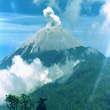|
Climbing
Permit
Request A Permit Letter
The Route
Distance & Time
Report
Climbing Arrangement
Prohibition
Punishment
The
Route
Map
Survival
Use A Compass
Preperation Checklist




|
GUIDANCE
FOR CLIMBERS
Climbing
Permit
Concerning
the letter of the Director of National Park and Recreation Forest
on March 5.1986 Nomor : 176/TN-1/1980 about recreation permit,
an issuing of entrance permit to the park is authority of the
Head of National Park/ Bureau of Nature Conservation office on
location.
The
condition of climbing permit requirement to Mount Semeru is as
follows :
For Students
Request of a permit letter know/approved by the head master ot
school
For Graduate Students
Request of a permit letter known/approved by the Dean of university
For Nature Lover
Request of a permit letter know/approved by the leader of nature
Lover
For Public
Request of a permit letter know/approved by the leader of community
Request of a permit letter should
contains :
a. Name and address of requester
b. Destination
c. Date and duration of climbing
d. Number of climbers including a list of name, address, gender
and age
The request of a permit letter addressed to :
Bromo Tengger Sermeru National Park Office :
JI. Raden Intan No.6, PO. Box. 54, Malang.
Phone (0341) 491 828, Fax (034l) 490 885
The request of a permit letter which is addressed to the Head
of Bromo Tengger Semeru National Park should be
received in the Bromo Tengger Semeru National Park office at least
1 (one) day before the date of doing climbing activ-ity. The climbing
permit letter is issued by the head of Bromo Tengger Semeru National
Park after climbers pay entrance tickets and accident insurance.
Helpful
Hints for Day Hiking
Just getting started in the outdoors?
Even expert hikers enjoy a day hike from time to time-ranging
from a few hours to a full day on mild to moderate terrain.
Dayhiking can be one of the easiest and most quickly rewarding
ways for you and your family to enjoy your time in state or national
parks and many other outdoor locales, especially if you follow
these simple guidelines:
Acquaint yourself with the area and its trails ahead of time so
you can set a reasonable timetable. Many guidebooks give time
estimates for trails.
To save fuel and avoid the nuisance of shuttling cars, plan hikes
that begin and end at the same parking area.
Carry more water than you think you'll need, as much as you can
comfortably carry. Fill your canteens before you leave. Backcountry
water sources are unpredictable.
Carry more food than you think you will need. It's better to take
extra snacks home with you than to go hungry on the trail. Store
your clothing and food in different colored sacks in your pack
so you can find them easily.
Put the items you need most frequently, such as your water bottle,
guidebook or jacket, at the top of your pack.
Weather on the trail can change quickly, especially in the mountains.
Layer your garments, and be prepared for severe weather.
If you are driving into remote regions, make sure your vehicle
is in good running order and top off your gas tank.
Start off slow to avoid fatigue partway through your hike. Take
frequent breaks.
Let the slowest member of your group set the pace. If skill levels
are dramatically different, break into groups and meet at agreed-upon
locations.
Practice low-impact hiking. Carry out whatever you pack in so
others can enjoy the surroundings, too.
To increase your chance of seeing wildlife, choose less traveled
trails and start your hike early in the morning. (When you
choose less traveled trails, you also help reduce erosion on overused
ones.)
Leave your itinerary with someone you trust, and check in with
them when you return.
|









